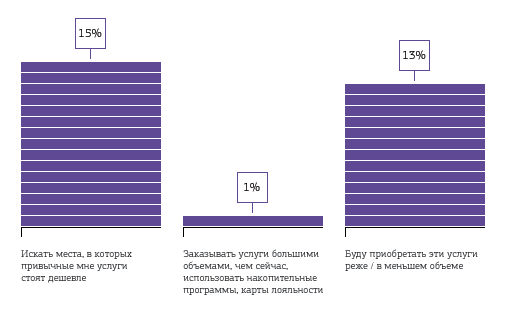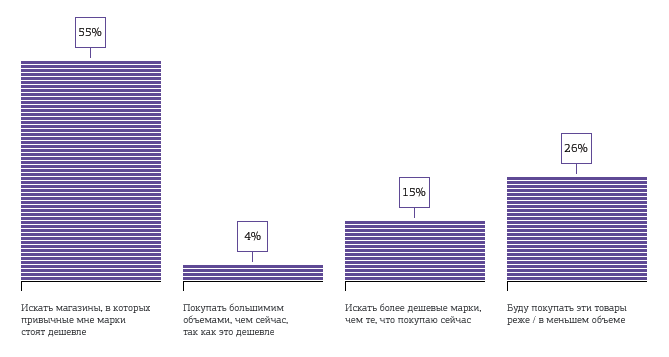Touch branding - where everything moves
Time unconditional trust advertising has passed. Now, in order to enter the house to the consumer, you need to become a “good friend” for all of his five senses. Welcome
in the sphere of the work of the sixth sense - “brand feelings”.
According to the published results of the study “Changes in behavior and consumer motivation during a crisis” *, which was conducted in the largest Russian cities in February 2009, it turned out that at the moment most consumers are trying to maintain their standard of living. In each category of goods and services there are well-known, "promoted" brands, the use of which has become for consumers an integral part of their life and image. Despite the fact that the crisis primarily affected the financial aspects (wages, bonuses), people do not want to “lower the bar” of life, which means that while the people are more attracted to the brand, not the price.
But this will not last long. In the course of the research it was revealed that over the course of the crisis, which promises to be protracted, consumer behavior will change according to the following scenario:
- at the initial stage, consumers will change their places of purchase (to those where the usual goods / services are cheaper);
- then they will begin to acquire the usual goods / services in a smaller volume;
- and, finally, will begin to change the familiar brands - switching to cheaper products / services will occur.
')
Here are some survey results confirming the above scenario.

Fig. 1: Service Savings Directions

Fig. 2: Savings Directions for Non-Food Products

Fig. 3: Savings Directions for Food
If at the initial stage of the crisis the old motives still remain relevant, in the future we should expect a decrease in consumer interest in the usual ways of promotion. The identified scenarios of changes in consumer behavior clearly indicate that the less people have money - the more likely they will change the usual brands in favor of cheaper ones. As a result, the need to retain its consumer is growing. The surest way out is to strengthen brand confidence.
In the "pre-crisis" times, few people were seriously engaged in nurturing customer loyalty and building strong brands. At least, simply because there was plenty of money on the market, consumption took place almost by itself. Business fought for quantitative, but not qualitative indicators. Recall the bloated budgets of advertising campaigns. Priority was given to the quantitative capture of market share. The number of promotional contacts, the commission of a one-time impulse purchase - that was what was important.
Today, brand loyalty comes first in importance and becomes not only desirable, but decisive for the survival of a brand in the market. Old product promotion technologies are losing their relevance. A new, innovative way to strengthen the brand is the technology of “sensory branding”, which is the controlled influence on all 5 consumer senses and the formation of the sixth sense - “brand sense”.
Our near future is a new consumer, which needs to be educated, instill in it a value system so that it returns to make a second purchase. The quality of customer contact with the brand - this is a key feature over which to work for survival. Is it possible to improve this figure only through the usual advertising and PR? Definitely not. Today, this is not enough for business to flourish. The brand should literally be "felt" by the consumer as positive in real contact.
Take, for example, the banking sector, which is currently experiencing the “crisis of confidence” most strongly. Banks do not trust people, people do not trust banks, and as a result, they don’t feel their money protected. Have you felt comfortable in at least one can? The most striking example is Sberbank. Isn't it funny - the investor brings his money into the organization and immediately faces a whole range of unpleasant feelings. Instead of a benevolent service, sullen and irritable operators, instead of a comfortable sofa for waiting, idle in long queues, instead of having an open stand for dialogue, an “address window” borrowed from the bureaucratic state apparatus of the Soviet era. The combination of these "small parts" produces a large, in this case a negative, effect.
The time has come for the branding agencies of the new generation to focus their main efforts precisely at the points of contact between the brand and the consumer. They will take the consumer position and conduct a “sensual audit” on the five senses, identifying painful points that generate dissatisfied customers.
An email, a phone call, a business card will tell a lot about you even before they met. The upholstery material in the waiting room, the contract form, the smell in the room, the shape and height of the “window for circulation” are all points of contact between the consumer and the brand. It is from these details, working on all five channels of the senses, that a strong friendship with the client develops.
To preserve this friendship for a long time, companies will have to “sensory optimization” of work processes. Having calculated all aspects of the brand's interaction with its audience, the agency engaged in “sensory optimization” should penetrate inside the business of its client in order to correct all the imperfections in contact with the consumer. To help the management of the company to organize the work of the divisions in such a way that consumers turn into reliable friends for many years, thanks to positive, manageable and planned impressions about the brand.
* - The article uses research data from Profi Online Research and Qualitel Data Services
in the sphere of the work of the sixth sense - “brand feelings”.
According to the published results of the study “Changes in behavior and consumer motivation during a crisis” *, which was conducted in the largest Russian cities in February 2009, it turned out that at the moment most consumers are trying to maintain their standard of living. In each category of goods and services there are well-known, "promoted" brands, the use of which has become for consumers an integral part of their life and image. Despite the fact that the crisis primarily affected the financial aspects (wages, bonuses), people do not want to “lower the bar” of life, which means that while the people are more attracted to the brand, not the price.
But this will not last long. In the course of the research it was revealed that over the course of the crisis, which promises to be protracted, consumer behavior will change according to the following scenario:
- at the initial stage, consumers will change their places of purchase (to those where the usual goods / services are cheaper);
- then they will begin to acquire the usual goods / services in a smaller volume;
- and, finally, will begin to change the familiar brands - switching to cheaper products / services will occur.
')
Here are some survey results confirming the above scenario.

Fig. 1: Service Savings Directions

Fig. 2: Savings Directions for Non-Food Products

Fig. 3: Savings Directions for Food
If at the initial stage of the crisis the old motives still remain relevant, in the future we should expect a decrease in consumer interest in the usual ways of promotion. The identified scenarios of changes in consumer behavior clearly indicate that the less people have money - the more likely they will change the usual brands in favor of cheaper ones. As a result, the need to retain its consumer is growing. The surest way out is to strengthen brand confidence.
In the "pre-crisis" times, few people were seriously engaged in nurturing customer loyalty and building strong brands. At least, simply because there was plenty of money on the market, consumption took place almost by itself. Business fought for quantitative, but not qualitative indicators. Recall the bloated budgets of advertising campaigns. Priority was given to the quantitative capture of market share. The number of promotional contacts, the commission of a one-time impulse purchase - that was what was important.
Today, brand loyalty comes first in importance and becomes not only desirable, but decisive for the survival of a brand in the market. Old product promotion technologies are losing their relevance. A new, innovative way to strengthen the brand is the technology of “sensory branding”, which is the controlled influence on all 5 consumer senses and the formation of the sixth sense - “brand sense”.
Our near future is a new consumer, which needs to be educated, instill in it a value system so that it returns to make a second purchase. The quality of customer contact with the brand - this is a key feature over which to work for survival. Is it possible to improve this figure only through the usual advertising and PR? Definitely not. Today, this is not enough for business to flourish. The brand should literally be "felt" by the consumer as positive in real contact.
Take, for example, the banking sector, which is currently experiencing the “crisis of confidence” most strongly. Banks do not trust people, people do not trust banks, and as a result, they don’t feel their money protected. Have you felt comfortable in at least one can? The most striking example is Sberbank. Isn't it funny - the investor brings his money into the organization and immediately faces a whole range of unpleasant feelings. Instead of a benevolent service, sullen and irritable operators, instead of a comfortable sofa for waiting, idle in long queues, instead of having an open stand for dialogue, an “address window” borrowed from the bureaucratic state apparatus of the Soviet era. The combination of these "small parts" produces a large, in this case a negative, effect.
The time has come for the branding agencies of the new generation to focus their main efforts precisely at the points of contact between the brand and the consumer. They will take the consumer position and conduct a “sensual audit” on the five senses, identifying painful points that generate dissatisfied customers.
An email, a phone call, a business card will tell a lot about you even before they met. The upholstery material in the waiting room, the contract form, the smell in the room, the shape and height of the “window for circulation” are all points of contact between the consumer and the brand. It is from these details, working on all five channels of the senses, that a strong friendship with the client develops.
To preserve this friendship for a long time, companies will have to “sensory optimization” of work processes. Having calculated all aspects of the brand's interaction with its audience, the agency engaged in “sensory optimization” should penetrate inside the business of its client in order to correct all the imperfections in contact with the consumer. To help the management of the company to organize the work of the divisions in such a way that consumers turn into reliable friends for many years, thanks to positive, manageable and planned impressions about the brand.
* - The article uses research data from Profi Online Research and Qualitel Data Services
Source: https://habr.com/ru/post/64537/
All Articles